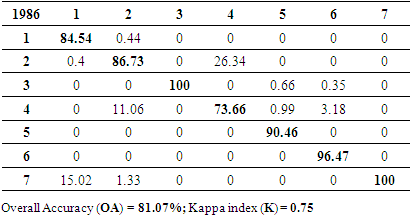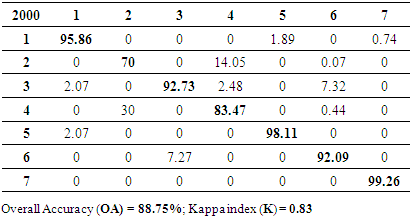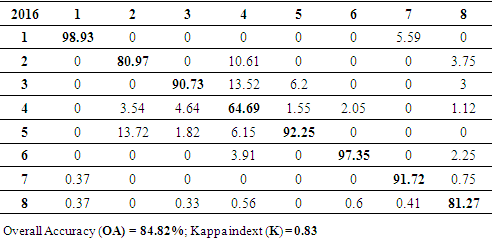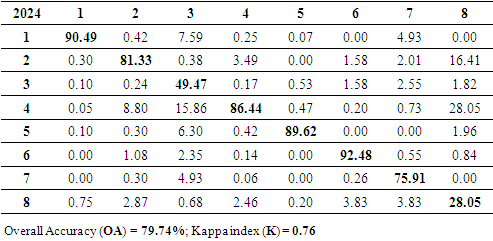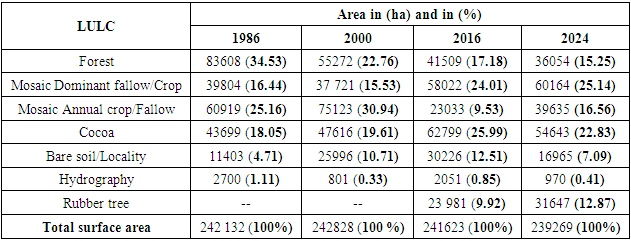| [1] | R. Blein, B.G. Soulé, B. Faivre-Dupaigre and B. Yérima Les potentialités agricoles de l’Afrique de l’Ouest. CEDEAO, Farm. (2008). |
| [2] | R. Balac Stratégies des jeunes dans une économie de plantation de l’Ouest ivoirien, Afrique contemporaine 259 (2016) 41-58. DOI: 10.3917/afco.3259.0041. |
| [3] | V. Ribier and J.J. Gabas Vers une accentuation des disparités dans le financement de l'agriculture en Afrique de l'Ouest ?, Cahiers Agricultures (2016) https://doi.org/10.1051/cagri/2016045. |
| [4] | F. Ruf Au cœur des cycles du cacao et des conflits en Afrique de l’Ouest: Le triangle Côte d’Ivoire, Ghana et Burkina Faso, Revue internationale des études du développement 3 (2020) 199-231. https://doi.org/110.3917/ried.3243.0199. |
| [5] | F. Ruf and J.L. Agkpo Etude sur le revenu et les investisssements des producteurs de café et de cacao en Côte d'Ivoire: rapport final. Mai 2008, (2008) DOI:10.13140/RG.13142.13141.14097.10089. |
| [6] | J. Oszwald Dynamique des formations agroforestières en Côte d‘Ivoire (des années 1980 aux années 2000), Suivi par télédétection et développement d‘une approche cartographique. Thèse de doctorat, Université des Sciences et Technologies de Lille, France, 304 p, (2005). |
| [7] | M. Koné Evolution du couvert forestier dense et impact de la déforestation sur la migration de la boucle du cacao en Côte d’Ivoire. Thèse de doctorat, Université Nangui Abrogoua (Abidjan), UFR Sciences de la nature, 166 p, (2015). |
| [8] | P. Jagoret, F. Ruf, C. Du Castel, J.M. Harmand, S. Rafflegeau, S. Saj, ... and T. Wibaux. L’agroforesterie: des pratiques diversifiées pour la transition agro-écologique de la cacaoculture africaine., La transition agro-écologique 59 (2019). |
| [9] | L.G. Youan, K.A. Kouadio and G.Y. Jean-Baptiste L’extension de la cacao-culture et la dégradation de l’environnement forestier dans le Département de Duekoué. Espace Géographique et Société Marocaine, (30). (2019). |
| [10] | N. Kalischek, N. Lang, C. Renier, R.C. Daudt, T. Addoah, W. Thompson, ... and J.D. & Wegner. Cocoa plantations are associated with deforestation in Côte d’Ivoire and Ghana, Nature Food 4 (2023) 384-393. DOI:310.1038/s43016-43023-00751-43018. |
| [11] | M. Koné, K. Kouadio, Y.L. Kouadio, D.F.R. Neuba, D.F. Malan and L. Coulibaly Évolution de la couverture forestière de la Côte d’Ivoire des années 1960 au début du 21e siècle, International Journal of Innovation and Applied Studies 7 (2014) 782 - 794. |
| [12] | FAO and SEP-REDD+ Données forestières de base pour la REDD+ en Côte d'Ivoire: Cartographie de la dynamique forestière de 1986 à 2015. SBN: 978-92-5-209999-4, 32p, (2017). |
| [13] | M. Koné, K. Kouadio, Y.L. Kouadio, D.F.R. Neuba and D.F. Malan Dégradation de la forêt dense humide tropicale, cas de l’Indénié-Djuablin à l’est de la Côte D’ivoire, Journal of Animal & Plant Sciences 21 (2014) 3324 - 3338. |
| [14] | I. Koffi, H. Dibi N’Da, K.G.C. Douffi, K.F. Kouamé and B.É. Koffi Impact of Cash Crops (Cocoa, Rubber Tree) on the Farmers’ Life Quality in Abengourou Department (East of Côte d’Ivoire), European Journal of Engineering Research and Science 5 (2020) 408 - 414. DOI:410.24018/ejers.22020.24015.24014.21782. |
| [15] | I. Koffi, N.H. Dibi, K.F. N’Dri, B.E. Koffi and K.F. Kouamé Apport de la Télédétection et des SIG à la caractérisation des mutations de cultures pérennes à base de Cacao et d’Hévéa dans l’ancienne boucle de Cacao : cas du département d’Abengourou (Sud-est de la Côte d’Ivoire), International Journal of Engineering and Science Invention 7 (2018) 01-12. |
| [16] | E. Dada and M. Hahn Application of satellite remote sensing to observe and analyse temporal changes of cocoa plantation in Ondo State, Nigeria, GeoJournal 87 (2022) 231-246. DOI: 210.1007/s10708-10020-10243-y. |
| [17] | T.D. Kanmegne, H. Latifi, T. Ullmann, R. Baumhauer, M. Thiel and J. Bayala Modelling the spatial distribution of the classification error of remote sensing data in cocoa agroforestry systems, Agroforestry Systems 97 (2023) 109-119. DOI: 110.1007/s10457-10022-00791-10452. |
| [18] | H. Pornon La géomatique, pour le meilleur et pour le pire, Géomatique Expert (2014) 100. |
| [19] | T. Brou Variabilité climatique, déforestation et dynamique agrodémographique en Côte d’Ivoire, Sécheresse 21 (2010) 1-6. |
| [20] | A.M. Kouassi, J.M. Kouao and K.E. Kouakou Caractérisation intra-annuelle de la variabilité climatique en Côte d’Ivoire, Bulletin de l’association de géographes français. Géographies 99 (2022) 289-306. https://doi.org/210.4000/bagf.9534. |
| [21] | RGPH Recensement Général de la Population et de l’Habitat (RGPH), 2021. Résultats globaux, 37 p, (2021). |
| [22] | N.E. Young, R.S. Anderson, S.M. Chignell, A.G. Vorster, R. Lawrence and P.H. Evangelista A survival guide to Landsat preprocessing, Ecology 98 (2017) 920-932. DOI: 910.1002/ecy.1730. |
| [23] | H. N’Da Dibi, K.E. N’guessan, W.M. Egnankou and K. Affian Apport de la télédétection au suivi de la déforestation dans le parc National de la Marahoué (Côte d’ivoire), Revue Télédétection 8 (2008) 17 - 34. |
| [24] | K.G.-C. Douffi, M. Koné, K.I. Kouassi, Y.J. N'Guessan and A. Bakayoko Farmers Establishment Impact on the Forest Dynamic of Monogaga Protected Forest, in the Southwest of Côte d'Ivoire: Remote Sensing and Geographical Information Systems (GIS) Approach, European Journal of Engineering Research and Science 4 (2019) 12-20. DOI: 10.24018/ejeng.22019.24014.24015.21230. |
| [25] | J.W. Rouse, R.H. Haas, D.W. Deering, J.A. Schell and J.C. Harlan Monitoring Vegetation Systems in the Great Plains with ERTS. P. 309-317, in S. C. Freden, E. E Mercanti & M. A. Becker (réd.), Third Earth Resources Technology Satellite Symposium Proceedings, Washington, D.C., 10-14 december 1973, NASA Science and Technology Information Office, Washington D.C., Publication NASA SP-351, vol. 1, (1973). |
| [26] | C. Chatelain Possibilités d’application de l’imagerie satellitaire à Haute Résolution pour l’étude des transformations de la végétation en Côte d’ivoire Foresterie. Thèse Univ. Geneve, 206 p, (1996). |
| [27] | A.J. Viera and J.M. Garrett Understanding interobserver agreement: the kappa statistic, Family Medicine 37 (2005) 360 - 363. |
| [28] | G.M. Foody Explaining the unsuitability of the kappa coefficient in the assessment and comparison of the accuracy of thematic maps obtained by image classification, Remote sensing of environment 239 (2020) 111630. |
| [29] | C. Noyola-Medrano, C. Mering and M.A. Rojas-Beltrán Evaluation du changement de l’occupation du sol à l’aide des images LANDSAT et SPOT: champ volcanique de la sierra chichinautzin (MEXIQUE). In Actes du 26eme colloque international., (2009). |
| [30] | FAO Forest resources assessment 1990 - Survey tropical forest cover studies of change processes. FAO Forestry Paper 130, Food and Agriculture Organization of United Nations, Rome, Italie. [en ligne] http://www.fao.org/docrep/007/w0015e/w0015e00.htm (dernière visite : 25 Janv. 2018), (1996). |
| [31] | J. Oloukoi, V.J. Mama and F.B. Agbo Modélisation de la dynamique de l’occupation des terres dans le département des Collines au Bénin, Télédétection 6 (2006) 304 - 323. |
| [32] | J.-P. Puyravaud Standardizing the calculation of the annual rate of deforestation, Forest Ecology et Management 177 (2003) 593-596. https://doi.org/510.1016/S0378-1127(1002)00335-00333. |
| [33] | R. Schlaepfer Analyse de la dynamique du paysage. Fiche d’enseignement 4.2, Laboratoire de Gestion des Ecosystèmes, Ecole Polytechnique de Lausanne, Suisse, (2002). |
| [34] | S.S. Rwanga and J.M. Ndambuki Accuracy assessment of land use/land cover classification using remote sensing and GIS, International Journal of Geosciences, 8 (2017) 611-622. https://doi.org/610.4236/ijg.2017.84033. |
| [35] | B. Tankoano, Z. Sanon, M. Hien, N.H. Dibi, J.T. Yameogo and I. Somda Pression anthropique et dynamique végétale dans la Forêt Classée de Tiogo au Burkina Faso: apport de la Télédétection, Tropicultura 34 (2016) 193-207. |
| [36] | A.A. Siradji, I.M. Maarouh, M. Mahamane, A.G. Ousseini, H.N.A. Latif, D. Soumana, B. Yacoubou and M. Ali Dynamique spatio-temporelle des écosystèmes de la Réserve de Biosphère de Gadabédji dans la zone Nord Sahélienne au centre du Niger, European Scientific Journal 20 (2024) 310-335. |
| [37] | A. Lipchitz and T. Pouch Les mutations des marchés mondiaux du café et du cacao, Géoéconomie 1 (2008) 101-124. DOI: 110.3917/geoec.3044.0101. |
| [38] | FAO Évaluation des ressources forestières mondiales (FRA) 2020 Côte d’Ivoire - Rapport, Rome, Italie, 55p, (2020) https://openknowledge.fao.org/handle/20.500.14283/cb10126fr. |
| [39] | F. Ruf L’adoption de l’hévéa en Côte d’Ivoire. Prix, mimétisme, changement écologique et social, Économie rurale 330 (2012) 103-124. https://doi.org/110.4000/economierurale.3527. |
| [40] | FAO Stratégie nationale de préservation, de réhabilitation et d'extension des forêts, 52p, (2022) https://faolex.fao.org/docs/pdf/ivc213819.pdf. |



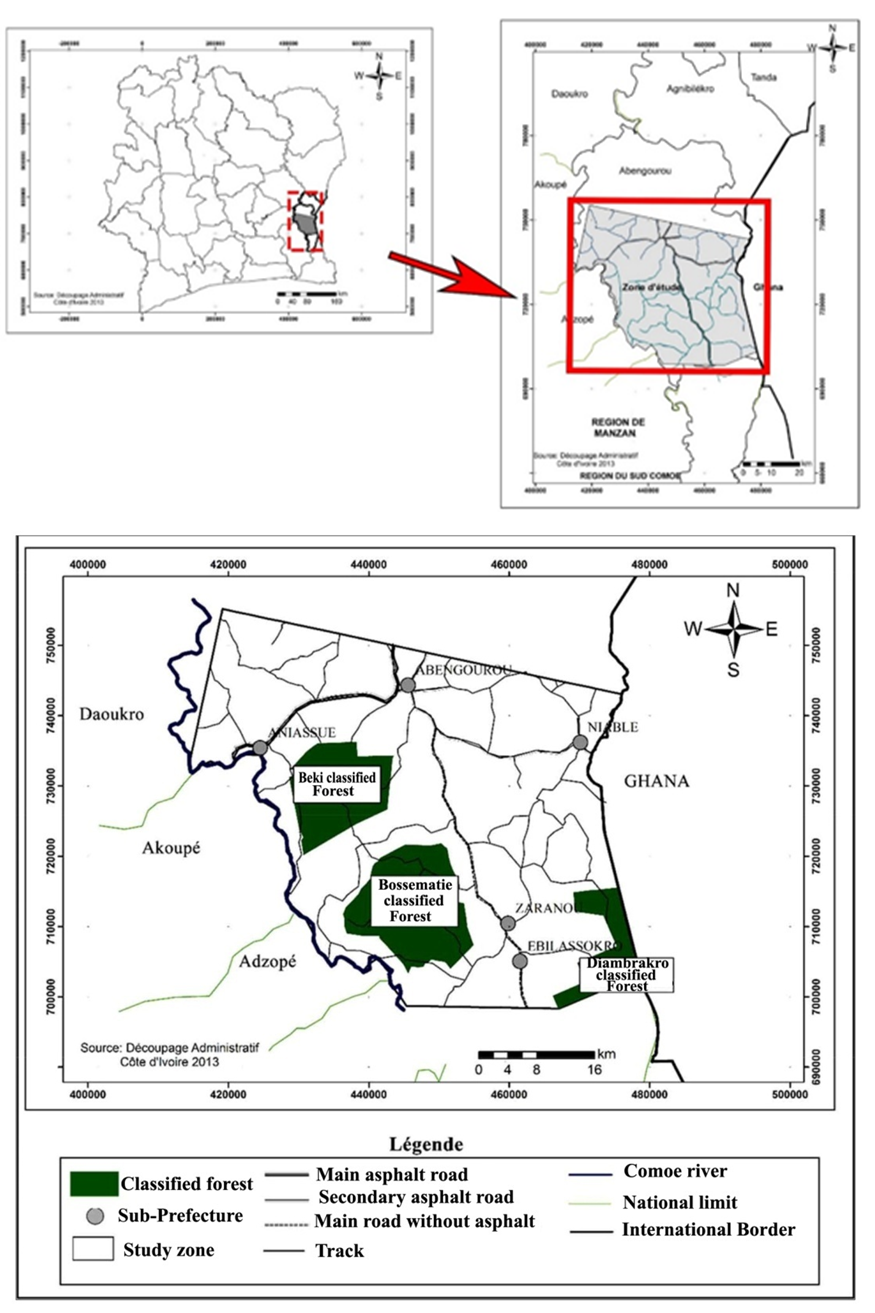
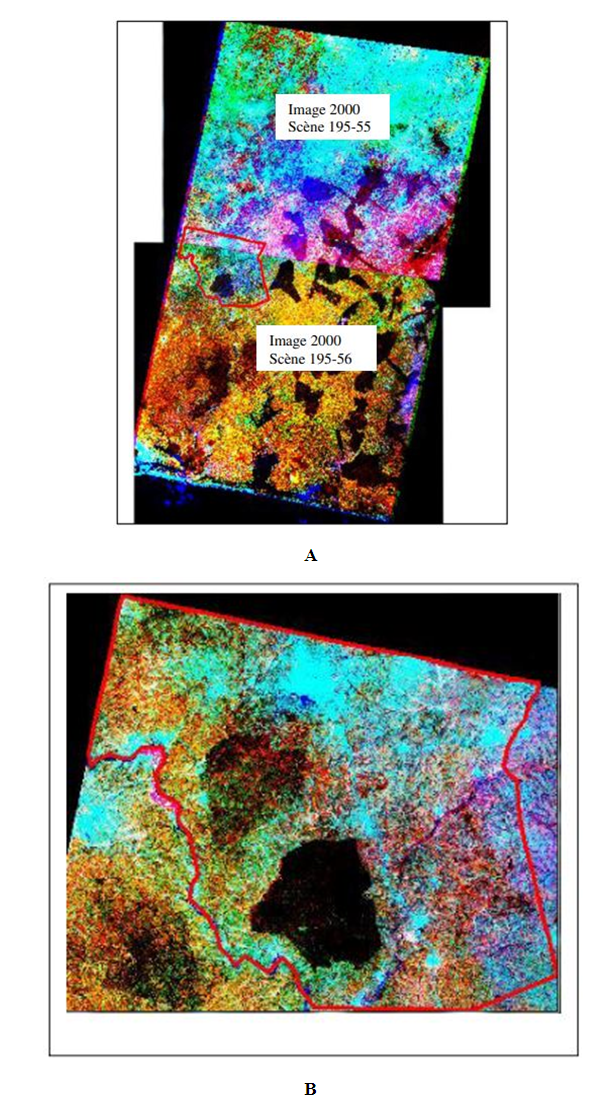



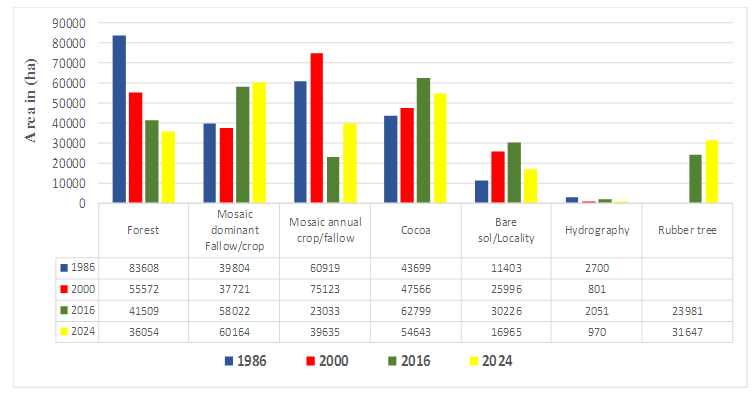
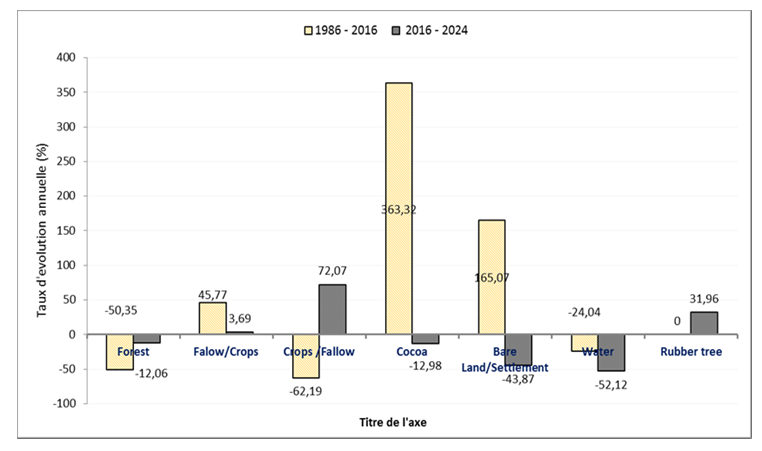
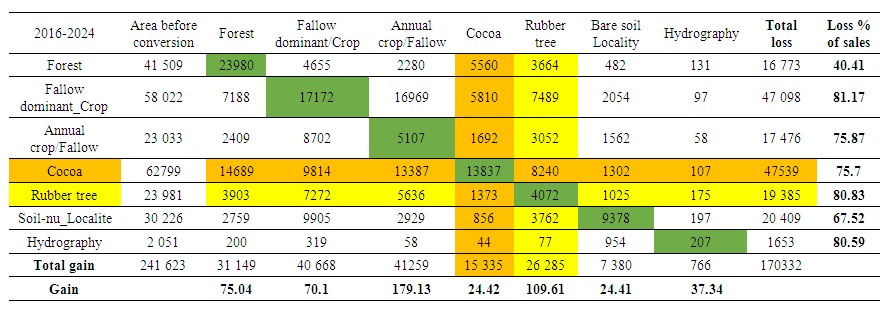
 Abstract
Abstract Reference
Reference Full-Text PDF
Full-Text PDF Full-text HTML
Full-text HTML
